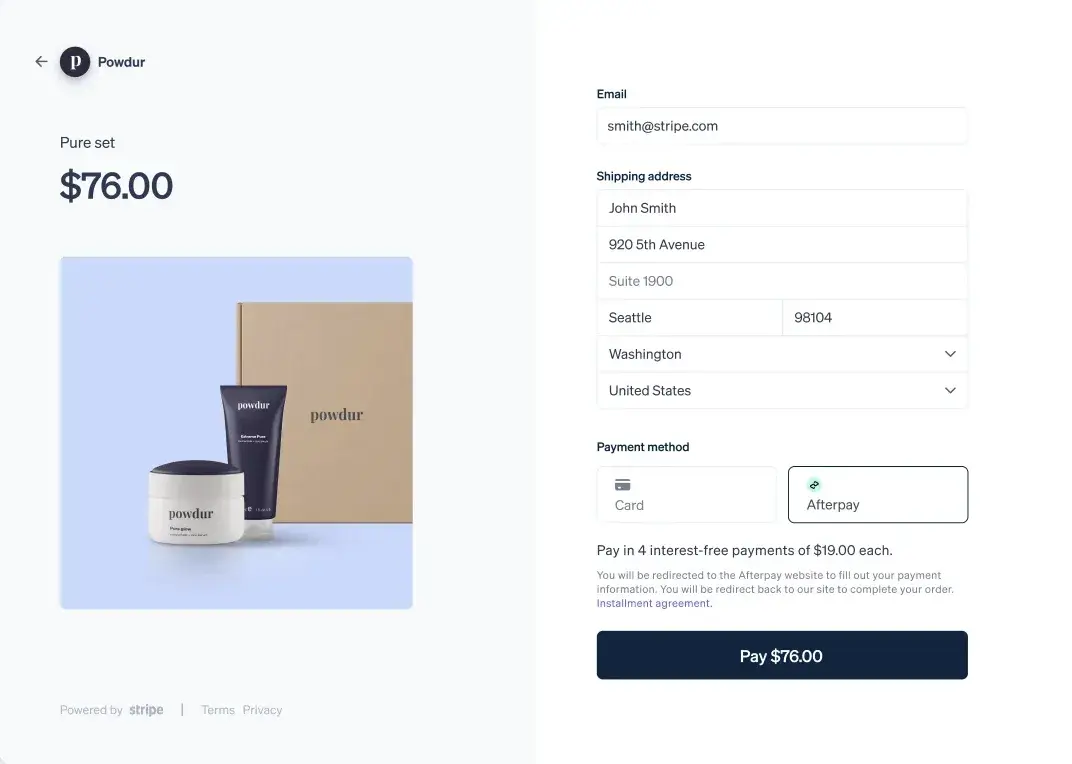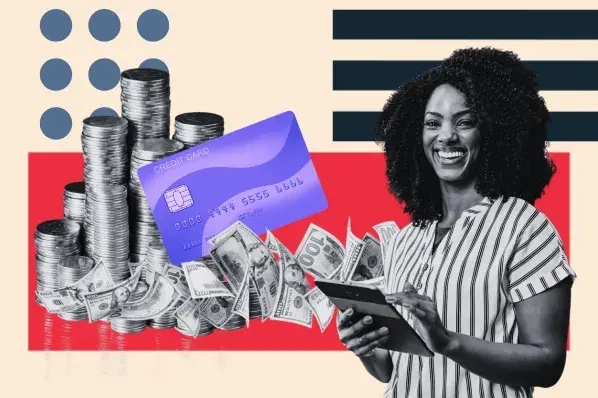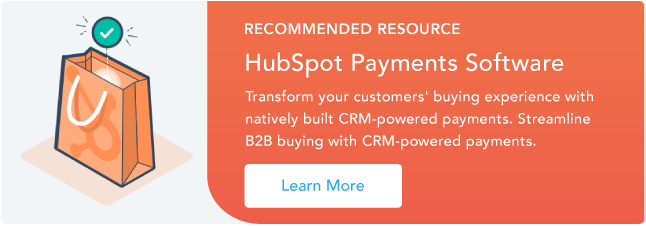Table of Contents
- What is a payment?
- What are the different types of payments?
- How to Accept Payments
- How to Choose the Right Payment Type for Your Business
What are the different types of payments?
We’ve come a long way since the days when payments were limited to cash or check. There are many different ways to pay or accept payments, both in person and online.
In my experience, there are benefits to each of these, depending on your business type. Let’s go over eight common types of payments available to businesses and customers.
Credit Card
Credit cards are the most common type of payment, according to data from Statista. Businesses can accept credit card payments both in person and online, making it a quick and convenient way for customers to make purchases or pay for services.
To accept credit card payments as a business, you need to have a payment processor, whether that’s an online payment gateway or a POS system for in-person purchases. You’ll also need a merchant account.
If you’re accepting a credit card payment in person, your POS will automatically capture the customer’s information once they swipe or tap their card. If a customer is paying online using a credit card, they will have to manually enter their card information. Keep this in mind for your ecommerce website — your payments page should be optimized for mobile to make entering this information easier for customers doing this on their phones.
What you need to know: Credit card payments have fees associated with every transaction. The fees vary depending on what payment processor you use, so do your research into different payment processors to understand exactly what the fees will be.
Debit Card
Like credit cards, debit cards are another popular and commonly used form of payment. If your payment processor can accept credit card payments, it should also be set up to accept debit cards.
The difference is that debit card payments aren’t attached to a line of credit. Instead, funds are directly pulled from a customer’s bank account. Debit cards are essentially a form of cash in that the payment happens instantly.
What you need to know: Debit card payments don’t have fees associated with transactions, making them ideal for both the customer and the business.
Automated Clearing House (ACH)
Automated Clearing House (ACH) payments are a form of electronic bank transfers. Also called bank payments, ACH involves paying directly from one bank to another.
This type of payment is useful for business-to-business transactions. For instance, if you sell services to another business like I do as a freelancer, ACH payments are convenient and easy to set up. ACH is used for direct deposit, a term you’re probably familiar with as either a business or an employee.
What you need to know: ACH payments are best for B2B payments or any business that pays a vendor for services.
Digital Payments
According to McKinsey, 9 out of 10 consumers say they used some form of digital payment over the past year. Digital payments include payments made through platforms like PayPal, Venmo, CashApp, or Zelle.
What you need to know: These payments are made through electronic funds transfers and there are fees associated.
.webp)
Mobile Wallets
A form of digital payment, mobile wallet payments refer to payments made through a mobile wallet like Apple Pay or Google Pay. They’re linked to the customer’s credit or debit card but can be accessed through their phone.
These types of payments are one of the fastest-growing methods. According to data from Statista, mobile wallets are predicted to become the second-most used POS payment method by 2027, right after credit cards.
It makes sense, too. Mobile wallets are convenient for customers who may not want to carry around all of their cards or a physical wallet if they’re on the go.
What you need to know: Mobile wallets are relevant to both in-person and online businesses. If you sell goods on a website or through social media, offering mobile wallet payments makes it even easier for your customers to make purchases.
Cash
In 2022, 41% of US adults reported making only cashless purchases in a typical week, according to a study by Pew Research Center. Many businesses have also joined the cashless trend, and it’s forecasted that cash will only have an 8% market share by 2027.
While cashless methods are becoming the norm, cash may still be the preferred method for small businesses that want to avoid credit card fees. It can also be a convenient way to pay for small transactions at places like coffee shops and convenience stores.
What you need to know: Cash is harder to track compared to credit cards or online payments. As a business owner, make sure you have a solid payment recording system in place if you plan to accept cash payments so nothing slips through the cracks.
Paper Check
While paper checks are less common than they used to be, they can still be useful for making large payments. Paper checks are connected to a payer’s bank account. Each check has the payer’s bank routing number and account number listed, and the payee’s bank uses those numbers to process the payment.
What you need to know: If you accept paper checks, you need to have an acceptance policy in place so your team and customers are prepared.
A typical check acceptance policy involves verifying the customer’s personal and banking information before you complete the transaction. Make sure the customer signs the check, writes their complete name and the dollar amount is correct.
Online Check
You can also accept e-checks, or online checks, as a form of payment for your business. Online checks are like paper checks but are considered a form of electronic funds transfer and are processed through the ACH network. To accept e-checks, you must use a payment processing system that processes ACH payments.
What you need to know: Processing online checks usually comes with a fee. The fee depends on the processing company you use, so be aware of this if you plan to accept online checks at your business.
How to Choose the Right Payment Type for Your Business
Choosing the right payment type depends on your business type. Whether you have a brick-and-mortar business, an ecommerce shop, or a service business, here are a few considerations.
1. Consider your needs.
Every business has different needs. For example, a coffee shop will accept different payment types than an online furniture store. A coffee shop would likely need to be able to accept credit and debit cards, mobile payments, and cash, while an online furniture store caters to large transactions and could offer Buy Now Pay Later (BNPL) options on its site.
You may also consider the fees associated with credit cards and online payment services. Fees are nearly impossible to avoid unless you have a cash-only business. The part you can control is which platform or service you choose, as they may have slightly different fees.
Another consideration is whether you need to charge recurring payments, one-time payments, or a mix of both.
If you sell services, like a pest control service, you may want to give customers an option to set up a monthly payment. In this case, you’d need to find a commerce tool that has recurring payments or subscriptions built in so your customers can easily pay, and you don’t have to worry about forgetting to send the bill.
2. Cater to your customers.
Your customers are the reason you’re in business, so they should be one of the top considerations when you’re thinking about the types of payment you want to offer.
If you’ve been in business for a while, you should have a good idea of who your customers are and how they prefer to pay.
For instance, let’s say you run a coffee shop, and you notice that more and more customers are paying with their mobile wallets. In this case, you can consider going cashless or optimizing the payment process at the checkout counter to make it quick and easy for them to tap their phone to pay.
If you’re not sure what your customers prefer, look at your sales data. How are people paying? What are the top three most common payment types? Focus on these methods and how you can improve customers’ experience by optimizing the payment process.
3. Determine your platform.
If you sell products or goods, you need a POS system that can accept and process multiple payment types, whether you sell in person or online.
If you sell in person, make sure your platform is equipped to accept mobile wallet payments, as that’s becoming a more popular payment method. For sellers with an ecommerce presence, your website should be optimized for mobile when people shop from their phones.

If you sell services, you could choose an invoicing platform that allows you to send invoices and collect payments in one place. Consider platforms like QuickBooks or Wave that not only have invoicing and payments but also keep your accounting in order. You can also use HubSpot’s Payment Links to send and accept payments without any website or coding required.
How to Accept Payments
Getting paid and accepting payments go hand in hand. Once you know which types of payment methods you want to accept, you need a reliable way to accept payments. Here’s what you need to equip yourself and your business.
Open a business bank account.
If you don’t already have one, your first step is to open a business bank account. A business bank account keeps business expenses and revenue separate from your personal bank account and should be used for all financials related to the business.
Plus, when you link your accounting software to your bank business bank account, it enables you to track your sales and expenses in one place, which helps keep your books organized.
Use a payment platform.
Whether you sell goods or services online or offline, you need a payment platform to accept and process payments. It’s common to use a payment service provider (PSP) to accept payments. Popular PSPs include PayPal, Square, and Stripe. These can be used to collect payments in person if they’re linked to your physical card reader or online if they’re embedded in your checkout page or used for payment links.
-1.webp)
Make Paying a Breeze
The types of payments available to customers and businesses have evolved so much that it’s now easier than ever to make a purchase. Keep this in mind if you’re a business owner: you want to make it easy for your customers to pay you.
I know that as a customer, I don’t want to think about what payment type I’m going to use if I’m online shopping or dining out. As a business owner, I want my clients to feel the same way.
Accepting a wide range of payment types gives your business flexibility, improves customer relationships, and can even increase sales. The more payment options you can provide, the more likely a customer will complete their purchase.
The key to choosing the right payment method depends on what your business is, who you cater to, and how your customers typically prefer to pay. If you want to narrow down your options, analyze how your customers pay.
If you notice that you haven’t had any cash transactions in the past year, it could be safe to go all in on cashless. Or, if you notice that your store gets more online sales than in-person, look into how you can optimize the payment process on your website.
Payments


.png)



.webp)


![ACH API: What it is + How to Use it [+ Who Should Not]](https://53.fs1.hubspotusercontent-na1.net/hubfs/53/ach-api.jpg)
![What is ACH credit [+ Is It Safe to Use?]](https://53.fs1.hubspotusercontent-na1.net/hubfs/53/what-is-ach-credit.jpg)


